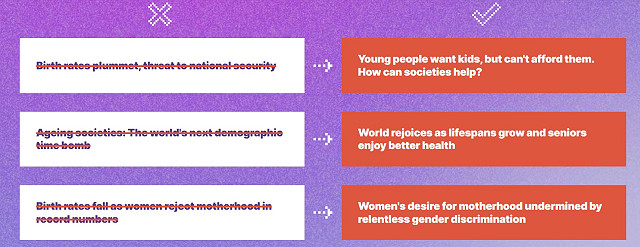Highlights
- In the new 2023 State of the World Population report, a very clear message comes through: “changing the narrative” about population is more important than changing policies. Post This
- In the pivot to a rights-based approach, the UNFPA has thrown the baby out with the bathwater. Post This
- The 2023 SWP continues the UNFPA’s longstanding advocacy of expansive reproductive rights and extends it to new breadth, using it as a tool to attack countries for trying to increase fertility rates. Post This
When a country’s leaders look at very high or low fertility rates, or sudden spikes in immigration, and they want guidance on how to respond, there is one place many will turn: the United Nations Population Fund (UNFPA). The UNFPA serves as a clearinghouse for population information and policy guidance around the world. Because this body can have a great deal of influence in shaping population policies, it’s important for those of us who care about family formation to pay attention to what the UNFPA is saying. In the new 2023 State of the World Population report (henceforth, 2023 SWP), a very clear message comes through: “changing the narrative” about population is more important than changing policies.
The report, which is one of UNFPA’s flagship documents outlining its views on population for the future, spends far more time discussing media, political, and popular narratives about population than it spends describing the state of world population. The major point of the document, which those of us who favor more support to families should heed, is that the UNFPA publicly argues that population policies are not good or bad based on whether they achieve some measurable outcome in the real world, but rather that policies are good or bad based on their tone, messaging, “primary objective,” or “narrative.” In other words, the UNFPA will condemn or approve identical policies with identical outcomes merely based on the politics and ideology of the governments advancing those policies. This biased way of assessing population policy shows up throughout the report and colors its findings.
That the world’s leading population statistics provider would take the view that public messaging is more important than empirical outcomes raises concerns about the neutrality of any data produced by the UNFPA.
Changing the Narrative Instead of the World
The 2023 SWP is subdivided into a few chunks: the first section describes population trends to the present. The next section criticizes overpopulation fears, following a section criticizing worries about population decline, capped off with a section about the importance of a rights-based approach to fertility. This rights-based approach is important to understand. Most people around the world agree that people have rights related to their fertility. Most of us would see forced sterilization or forced abortion as wrong. Most of us would also see forced pregnancy as wrong. In fact, all of these are internationally recognized crimes against humanity. However, the rights-based approach the 2023 SWP adopts is not based in these kinds of negative rights, or rights to be free of external coercion. Rather, it is based on a set of positive rights: that all people have a right to determine the number, timing, and spacing of their children, and that this right of determination primarily implies unrestricted access to contraception and abortion. In one section, the report even seems to suggest that abortion restrictions could constitute “forced pregnancy” under international law, a view not shared by any existing international legal body or tribunal (under current law, forced pregnancy primarily refers to wartime rape or the use of sexual violence as a form of social control by governments). Thus, the view of rights the 2023 SWP is advancing is unique. It is in one regard expansive (covering many positive rights to make claims on others), and in another regard extremely specific (mostly focused on abortion and contraception and to some extent IVF, not, say, child allowances or baby bonuses).
The point of this rights-based framework in the 2023 SWP is to contrast it with alternative frameworks, which the UNFPA describes as “targets.” Essentially, the 2023 SWP sets up a contrast between “population targets” and “protecting rights and empowering people.” From the website that introduces the report, this contrast is made explicit. Consider the image below discussing concerns about fertility being too low:

The reason the 2023 SWP crosses out “Birth rates plummet, threat to national security” is not that the claim is false, but that it might have bad implications for individual rights as the UNFPA sees them: countries might prioritize national security over rights. Likewise, the reason that concerns about ageing are crossed out is not because the claim is false, but because it implies some kind of urgent action is needed, and the UNFPA worries that urgency will give rise to rights violations. This kind of concern is what the UNFPA means when it criticizes “alarmism”—the UNFPA apparently believes that if societies become too informed about demographic change (“alarmist”), they will adopt policies the UNFPA believes are bad. The reason the UNFPA strikes out the falling birth rates line is, again, not because it is false (though it is oversimplified), but because it is not as useful for the UNFPA’s preferred policy agenda as the proposed alternative, which peddles the clearly false view that gender discrimination is the main cause of low fertility.
In essence, when the UNFPA criticizes “targets,” it is really criticizing empirical, data-informed, outcomes-based assessment. The UNFPA is arguing that messaging matters most.
But the UNFPA goes further and seems sympathetic to more active manipulation of public information about demography. Findings from an 8,000-person survey across eight countries found that people who saw more media presentations of population topics were more worried about low fertility and high immigration. Most people would interpret that to mean that as people become better informed about demography, they realize that low fertility rates and very high immigration rates may, in fact, be serious social challenges that require careful management by policymakers. But that is not the UNFPA’s view—it interprets these results by saying, “what is clear is the value of ensuring that rights and choices remain central in dialogue and messaging around population issues.” In other words, the people are getting the wrong message, and the media needs to be brought into line.
The list of cases of messaging outweighing facts could go on, but one final egregious example is worth highlighting: the question of financial incentives. The first time the 2023 SWP discusses incentives, it says, “In their most benign form, [population policies] include incentives and disincentives, but for people facing multiple overlapping forms of vulnerability…they can have the effect of eliminating choice altogether.”
In other words, giving baby bonuses or child allowances (an incentive) is a form of coercion against vulnerable people, which the UNFPA clearly views as a bad thing. But then a few pages later, the report says that one way to “put people at the centre” and “promote opportunities, empowerment, and choice for women” is to “offset the costs of child-rearing through payments or tax credits.” This is baffling, since those are very clearly incentives. The same incentives are coercion when framed as pronatal policies, but empowerment when framed as offsetting childrearing costs. As if sensing the issue, a few pages later the report notes:
Many of these [incentives] are, in fact, standard social and welfare policies recommended irrespective of fertility concerns. But when these policies have as their primary objective influence over… fertility, there are significant perils.
This is an incredible statement—it is as if the UNFPA is saying that a policy should not be judged by its actual effects, but rather by the narrative or messaging around it.
In the pivot to a rights-based approach, the UNFPA has thrown the baby out with the bathwater. Yes, rights are important, but what matters for rights are actual real world effects, not public messaging and media narratives. If a country adopts a program that eliminates child poverty and justifies it through pronatal arguments, as Poland has done with its zloty 500+ program, that is a good thing! That the policy has a pronatal motivation is totally irrelevant to assessing whether it is a good policy or not. By focusing on form over substance, the UNFPA is wasting its limited resources on trivialities, needlessly hectoring governments for the political strategies they deem necessary to build electoral coalitions in favor of child-welfare-promoting policies, and calling into question its own credibility. Can we trust that the UNFPA is neutral in its collection and presentation of data?
About the Data
The 2023 SWP included findings from a survey about population issues conducted in 8 countries (USA, Brazil, Egypt, France, Hungary, India, Japan, and Nigeria). This report asked a range of fascinating and important questions: whether people think fertility in their country is too high or too low, whether immigration is too high or too low, which population issues are of concern, etc. This is a welcome approach to studying population policy.
Likewise, the 2023 SWP repeatedly makes a statement that I have argued for many times: fertility rates below what women say they want represent a failure of reproductive agency and autonomy. When whole societies have large gaps between their stated desires and actual outcomes, it’s a bad sign. On this, the UNFPA evidently shares firm agreement with IFS (and in fact, my own work in these areas is cited in the SWP). This makes it all the more surprising that the SWP’s 8-country survey did not actually include a question about fertility preferences. When it fielded its own survey of population matters, the UNFPA still didn’t ask people what they actually wanted. This reveals a troubling inconsistency in the UNFPA’s claims to value fertility preferences, which becomes a grievous problem when the report discusses the reason behind the survey's design:
Ultimately, a numerical lens—reviewing averages, rates and proportions—provides a critical glimpse into understanding just how far there is yet to go in building a world where every individual has the knowledge and ability to realize their reproductive goals. But just as important is understanding how words and language—and how we view the role of the family (see page 117)—matter for the journey as well.
Put in layman’s terms, the narrative about population policy is as important as whether people are actually, in empirical terms, achieving their aspirations.
And in using the data, there are some egregious mistakes. The report makes the misleading argument that public concern about government responses to population change is one of the top three population-related worries reported in the survey—yet this result is only arrived at by aggregating the actual response options into groups, and uneven groups at that, with some categories made up of just one actual response option, others containing as many as four. Even though the main worries people reported were overwhelmingly economic, the report makes it seem as if, around the world, hundreds of millions are people are worried that their governments might adopt some kind of incentive program. To add insult to injury, the report fails to make clear that worries about “population policies” were lopsided: the two highest countries on this were India and Nigeria (both countries where the government is trying to reduce fertility), and yet the UNFPA actually singled out Hungary for critique on this question, because its policies are pronatal.1
Conclusion
The 2023 SWP continues the UNFPA’s longstanding advocacy of expansive reproductive rights and extends it to new breadth, using it as a tool to attack countries for trying to increase fertility rates when they are lower than citizens report wanting. The UNFPA’s view in this report seems to be that policies cannot be judged based on their actual outcomes, but instead should be judged based on their messaging and narrative. This raises concerns about whether the UNFPA is a body with a neutral message. That the UNFPA made its theme this year opposition to population policies per se is not trivial—recent past themes have been unintended pregnancy, sexual violence, female genital mutilation, and the COVID-19 pandemic. Evidently, the UNFPA views countries having family policies as a threat that is as similar to well-being as the pandemic or female genital mutilation, an extraordinary symmetry.
Rather than buy into the UNFPA’s alarmist arguments about population policy, countries should take a more straightforward rights-based approach: when fertility rates are far below or above what women say they want, that’s a bad thing. It suggests barriers to reproductive autonomy. In general, countries should have targets consistent with what people want: family policies should support the desire to get married, having as many children as one desires, and raising those children in a safe environment. In most countries around the world today, as the 2023 SWP acknowledges, women have fewer children than they want. This is cause for concern, and it is sufficient justification for most countries to consider adopting a broad spectrum of voluntary pronatal policies.
Lyman Stone is a Research Fellow at the Institute for Family Studies and Chief Information Officer of the population research firm Demographic Intelligence.
1. The UNFPA’s survey of population concerns is a complicated survey instrument which defies easy interpretation. For example, the report says that “Concerns over sexual and reproductive health and rights policies and over human rights generally ranked as the third most commonly selected priority in the aggregate,” and singles out Hungary, a country with low current fertility and some significant pro-natal policies, as a country where these concerns may exist. Summarizing the findings, the report concludes “Sexual and reproductive health and rights, and human rights more broadly, are indeed at the front of many people’s minds when population issues are discussed, and therefore rights can and should have a central place in these conversations.”
But this is absolute nonsense. First of all, the question these claims come from is bafflingly worded: “Thinking specifically about possible changes to your country’s population, which two or three, if any, of the following do you think are the most important issues? Please select up to three options. (from a list of issues provided).” The connection between the “issues” and “changes to population” is totally unclear: are these issues respondents believe have caused changes? Are they changes that will be caused? Are they issues respondents hope will be raised, or that they fear will be raised?
It is completely unclear what respondents meant in their answers to this poorly designed question—and even then, the UNFPA’s interpretation makes no sense. To create their combined category of worries about reproductive rights, they combine three categories: governments imposing family size policies, governments imposing policies on abortion and contraception, and loss of human rights. Presumably everybody agrees lost human rights are bad—but what did respondents have in mind for government policies? They might worry abortion would be banned—but they might worry abortion would be coerced! They might worry about “family size policies” setting family size limits—or family size minimums! They might hope population change leads their government to impose family size policies—or fear that outcome!
As it is, the country where “family size policies” were most commonly cited was actually India, followed by Nigeria. India especially does have laws discriminating against big families, and Nigeria’s government also actively encourages fertility reduction. Hungary’s pronatal policies aren’t the standout here—India and Nigeria’s antinatal policies are. When it comes to policies about abortion and contraception, the country where people cited that issue the most was the United States—and yet the United States has the most liberal abortion laws of any of the eight countries studied!
To add to the incoherence, the UNFPA combines these two worries and human rights generally into one category, but then in other cases compares this three-part category to environmental concerns (just one item); population decline (one item); conflict and tensions (unclear, somewhere between two and five items); slums and urban sprawl (one item); culture, ethnicity, and racism (three items representing an extraordinary concept collapse—the UNFPA treats concerns about culture as identical to overt racism); and all economic effects (unclear, between three and five items). The point is, these are not equal categories. The 2023 SWP combines categories in order to support the narrative that there is deep and broad concern about reproductive rights being threatened by population policies, when in fact there is not. In no country do family size policy worries exceed 15%, and in most countries both family size policies and abortion/contraception policies are shared by fewer than 10% of respondents.















